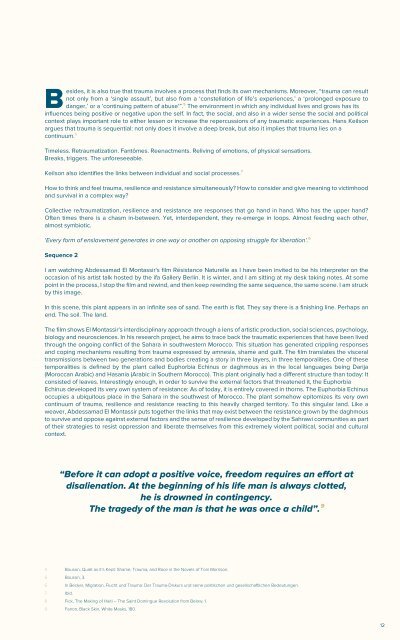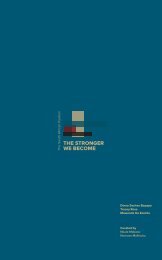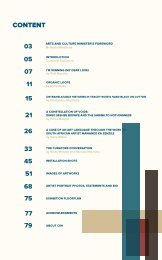The-Stronger-We-Become-Catalogue
Create successful ePaper yourself
Turn your PDF publications into a flip-book with our unique Google optimized e-Paper software.
Besides, it is also true that trauma involves a process that finds its own mechanisms. Moreover, “trauma can result<br />
not only from a ‘single assault’, but also from a ‘constellation of life’s experiences,’ a ‘prolonged exposure to<br />
danger,’ or a ‘continuing pattern of abuse’”.⁵ <strong>The</strong> environment in which any individual lives and grows has its<br />
influences being positive or negative upon the self. In fact, the social, and also in a wider sense the social and political<br />
context plays important role to either lessen or increase the repercussions of any traumatic experiences. Hans Keilson<br />
argues that trauma is sequential: not only does it involve a deep break, but also it implies that trauma lies on a<br />
continuum.⁶<br />
Timeless. Retraumatization. Fantômes. Reenactments. Reliving of emotions, of physical sensations.<br />
Breaks, triggers. <strong>The</strong> unforeseeable.<br />
Keilson also identifies the links between individual and social processes.⁷<br />
How to think and feel trauma, resilience and resistance simultaneously? How to consider and give meaning to victimhood<br />
and survival in a complex way?<br />
Collective re/traumatization, resilience and resistance are responses that go hand in hand. Who has the upper hand?<br />
Often times there is a chasm in-between. Yet, interdependent, they re-emerge in loops. Almost feeding each other,<br />
almost symbiotic.<br />
‘Every form of enslavement generates in one way or another an opposing struggle for liberation’.⁸<br />
Sequence 2<br />
I am watching Abdessamad El Montassir's film Résistance Naturelle as I have been invited to be his interpreter on the<br />
occasion of his artist talk hosted by the ifa Gallery Berlin. It is winter, and I am sitting at my desk taking notes. At some<br />
point in the process, I stop the film and rewind, and then keep rewinding the same sequence, the same scene. I am struck<br />
by this image.<br />
In this scene, this plant appears in an infinite sea of sand. <strong>The</strong> earth is flat. <strong>The</strong>y say there is a finishing line. Perhaps an<br />
end. <strong>The</strong> soil. <strong>The</strong> land.<br />
<strong>The</strong> film shows El Montassir's interdisciplinary approach through a lens of artistic production, social sciences, psychology,<br />
biology and neurosciences. In his research project, he aims to trace back the traumatic experiences that have been lived<br />
through the ongoing conflict of the Sahara in southwestern Morocco. This situation has generated crippling responses<br />
and coping mechanisms resulting from trauma expressed by amnesia, shame and guilt. <strong>The</strong> film translates the visceral<br />
transmissions between two generations and bodies creating a story in three layers, in three temporalities. One of these<br />
temporalities is defined by the plant called Euphorbia Echinus or daghmous as in the local languages being Darija<br />
(Moroccan Arabic) and Hasania (Arabic in Southern Morocco). This plant originally had a different structure than today: It<br />
consisted of leaves. Interestingly enough, in order to survive the external factors that threatened it, the Euphorbia<br />
Echinus developed its very own system of resistance: As of today, it is entirely covered in thorns. <strong>The</strong> Euphorbia Echinus<br />
occupies a ubiquitous place in the Sahara in the southwest of Morocco. <strong>The</strong> plant somehow epitomizes its very own<br />
continuum of trauma, resilience and resistance reacting to this heavily charged territory. To this singular land. Like a<br />
weaver, Abdessamad El Montassir puts together the links that may exist between the resistance grown by the daghmous<br />
to survive and oppose against external factors and the sense of resilience developed by the Sahrawi communities as part<br />
of their strategies to resist oppression and liberate themselves from this extremely violent political, social and cultural<br />
context.<br />
“Before it can adopt a positive voice, freedom requires an effort at<br />
disalienation. At the beginning of his life man is always clotted,<br />
he is drowned in contingency.<br />
<strong>The</strong> tragedy of the man is that he was once a child”.⁹<br />
4 Bouson, Quiet as it’s Kept: Shame, Trauma, and Race in the Novels of Toni Morrison.<br />
5 Bouson, 3.<br />
6 In Becker, Migration, Flucht und Trauma: Der Trauma-Diskurs und seine politischen und gesellschaftlichen Bedeutungen.<br />
7 Ibid.<br />
8 Fick, <strong>The</strong> Making of Haiti – <strong>The</strong> Saint Domingue Revolution from Below, 1.<br />
9 Fanon, Black Skin, White Masks, 180.<br />
12




